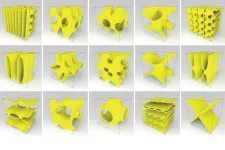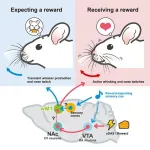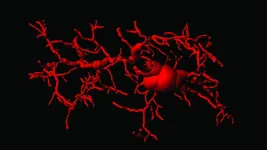(Press-News.org) Engineers are constantly searching for materials with novel, desirable property combinations. For example, an ultra-strong, lightweight material could be used to make airplanes and cars more fuel-efficient, or a material that is porous and biomechanically friendly could be useful for bone implants.
Cellular metamaterials — artificial structures composed of units, or cells, that repeat in various patterns — can help achieve these goals. But it is difficult to know which cellular structure will lead to the desired properties. Even if one focuses on structures made of smaller building blocks like interconnected beams or thin plates, there are an infinite number of possible arrangements to consider. So, engineers can manually explore only a small fraction of all the cellular metamaterials that are hypothetically possible.
Researchers from MIT and the Institute of Science and Technology Austria have developed a computational technique that makes it easier for a user to quickly design a metamaterial cell from any of those smaller building blocks, and then evaluate the resulting metamaterial’s properties.
Their approach, like a specialized CAD (computer-aided design) system for metamaterials, allows an engineer to quickly model even very complex metamaterials and experiment with designs that may have otherwise taken days to develop. The user-friendly interface also enables the user to explore the entire space of potential metamaterial shapes, since all building blocks are at their disposal.
“We came up with a representation that can cover all of the different shapes engineers have traditionally shown interest in. Because you can build them all the same way, that means you can switch between them more fluidly,” says MIT electrical engineering and computer science graduate student Liane Makatura, co-lead author of a paper on this technique.
Makatura wrote the paper with co-lead author Bohan Wang, an MIT postdoc; Yi-Lu Chen, a graduate student at the Institute of Science and Technology Austria (ISTA); Bolei Deng, an MIT postdoc; Chris Wojtan and Bernd Bickel, professors at ISTA; and senior author Wojciech Matusik, a professor of electrical engineering and computer science at MIT who leads the Computational Design and Fabrication Group within the MIT Computer Science and Artificial Intelligence Laboratory. The research will be presented at SIGGRAPH.
A unified method
When a scientist develops a cellular metamaterial, she typically begins by choosing a representation that will be used to describe her potential designs. This choice determines the set of shapes that will be available for exploration.
For instance, she may choose a technique that represents metamaterials using many interconnecting beams. However, this prevents her from exploring metamaterials based on other elements, such as thin plates or 3D structures like spheres. Those shapes are given by different representations, but so far, there hasn’t been a unified way to describe all shapes in one method.
“By choosing a specific subspace ahead of time, you limit your exploration and introduce a bias based on your intuition. While this can be useful, intuition can be incorrect, and some of the other shapes may have also been worth exploring for your particular application,” says Makatura.
She and her collaborators took a step back and closely examined different metamaterials. They saw that the shapes that comprise the overall structure could be easily represented by lower-dimensional shapes — a beam could be reduced to a line or a thin-shell could be compressed to a flat surface.
They also noticed that cellular metamaterials often have symmetries, so only a small part of the structure needs to be represented. The rest can be built by rotating and mirroring that initial piece.
“By combining those two observations, we arrived at this idea that cellular metamaterials could be well-represented as a graph structure,” she says.
With their graph-based representation, a user builds a metamaterial skeleton using building blocks that are created by vertices and edges. For instance, to create a beam structure, one places a vertex at each end point of the beam and connects them with a line.
Then the user employs a function over that line to specify the thickness of the beam, which can be varied so one part of the beam is thicker than another.
The process for surfaces is similar — the user marks the most important features with vertices and then chooses a solver that infers the rest of the surface.
These easy-to-use solvers even allow users to quickly construct a highly complex type of metamaterial, called a triply periodic minimal surface (TPMS). These structures are incredibly powerful, but the usual process to develop them is arduous and prone to failure.
“With our representation, you can also start combining these shapes. Perhaps a unit cell containing both a TPMS structure and a beam structure could give you interesting properties. But so far, those combinations really haven’t been explored to any degree,” she says.
At the end of the process, the system outputs the entire graph-based procedure, showing every operation the user took to reach the final structure — all the vertices, edges, solvers, transformations, and thickening operations.
Within the user interface, designers can preview the current structure at any point in the building procedure and directly predict certain properties, such as its stiffness. Then, the user can iteratively tweak some parameters and evaluate it again until a suitable design is reached.
A user-friendly framework
The researchers used their system to recreate structures that spanned many unique classes of metamaterials. Once they had designed the skeletons, each metamaterial structure took only seconds to generate.
They also created automated exploration algorithms, giving each a set of rules and then turning it loose in their system. In one test, an algorithm returned more than 1,000 potential truss-based structures in about an hour.
In addition, the researchers conducted a user-study with 10 individuals who had little prior experience modeling metamaterials. The users were able to successfully model all six structures they were given, and most agreed that the procedural graph representation made the process easier.
“Our representation makes all sorts of structures more accessible to people. We were especially pleased with users’ ability to generate TPMS. These complex structures are usually difficult even for experts to generate. Still, one TPMS in our study had the lowest average modeling time out of all six structures, which was surprising and exciting,” she says.
In the future, the researchers want to enhance their technique by incorporating more complex skeleton thickening procedures, so the system can model a wider variety of shapes. They also want to continue exploring the use of automatic generation algorithms.
And in the long term, they’d like to use this system for inverse design, where one would specify desired material properties and then use an algorithm to find the optimal metamaterial structure.
This research is funded, in part, by a National Science Foundation Graduate Research Fellowship, the MIT Morningside Academy Design Fellowship, the Defense Advanced Research Projects Agency (DARPA), an ERC Consolidator Grant, and the NewSat project.
###
Written by Adam Zewe, MIT News Office
Paper: “Procedural Metamaterials: A Unified Procedural Graph for Metamaterial Design”
https://dl.acm.org/doi/10.1145/3605389
END
New method simplifies the construction process for complex materials
With a new, user-friendly interface, researchers can quickly design many cellular metamaterial structures that have unique mechanical properties.
2023-08-02
ELSE PRESS RELEASES FROM THIS DATE:
Dimensions to boost discoverability of Oxford University Press online journals and books
2023-08-02
The world’s largest linked research database, Dimensions, will grow its knowledge base even further, thanks to a new partnership with the world’s largest university press, Oxford University Press (OUP).
Under the agreement, more than 27,000 books and 500 journal titles from OUP’s Oxford Academic digital publishing platform will be fully indexed and discoverable in Dimensions, adding another rich resource of academic material to the world’s largest research database, in fields such as the arts, humanities, economics, science, technology, history, and politics.
The move will enable users of Dimensions – a flagship Digital Science product – ...
A visual feast
2023-08-02
3D light sculptures. Tsunami waves on a beach. Previewing color tattoos. Contributions from the Bickel and Wojtan groups at the Institute of Science and Technology Austria (ISTA) to the 2023 SIGGRAPH conference tackle an impressive variety of classic and novel questions. While their focuses range from computer graphics to fabrication methods, the computer scientists are united in finding cost-effective, innovative solutions and empowering users.
SIGGRAPH is the top worldwide annual convention for computer graphics and interactive techniques, bringing ...
Important step toward next-generation probiotics
2023-08-02
One of the beneficial gut bacteria residing in the human gut, which normally cannot survive in an environment with oxygen, can now be made oxygen-tolerant. This is a key finding in the development of future probiotic treatment that is now being explored to improve glucose control in individuals with prediabetes.
Our intestines are home to trillions of bacteria, the gut microbiota, which are important for functions such as digesting food and educating and activating the immune system. During the past decade it has been clarified that changes in the bacterial composition can be linked to various diseases.
Significant expectations have been attributed to the next generation ...
Infertility may lead to more severe menopause symptoms
2023-08-02
CLEVELAND, Ohio (August 2, 2023)—Not all women experience menopause the same way. The severity of menopause symptoms is influenced by a multitude of behavioral, biological, social, psychological, and demographic factors. A new study suggests that infertility may also be a risk factor for some menopause symptoms, including depressive mood, irritability, and sleep problems. Results of the study are published online today in Menopause, the journal of The Menopause Society.
A woman’s reproductive history has been implicated as a factor in the timing of menopause onset and the prevalence of menopause ...
Unveiling the mechanism underlying orofacial movements during reward processing in animals
2023-08-02
In animals, movements such as locomotion or grooming are known to influence neuronal activity within the cerebral cortex. Moreover, recent studies also suggest that these changes in neuronal activity are not confined to a specific area but are pervasive throughout cortical and subcortical regions of the brain. Interestingly, in animals trained for reward-based learning tasks, such spontaneous movements—despite being uninstructed and unnecessary—may be aligned to task events and may significantly contribute to ...
How immunity contributes to ageing and neurodegeneration
2023-08-02
As we age, our bodies undergo various changes that can impact our overall health and make us more susceptible to diseases. One common factor in the ageing process is low-grade inflammation, which contributes to age-related decline and impairment. However, the precise pathways responsible for this inflammation and their impact on natural ageing have remained elusive until now.
A new study led by Andrea Ablasser at EPFL now shows that a molecular signaling pathway called cGAS/STING, plays a critical role in driving chronic inflammation and functional decline during aging. By blocking the STING protein, the researchers were able to suppress inflammatory responses in senescent ...
Cost of translating consent documents may serve as a barrier to participation of members of underrepresented groups in clinical trials
2023-08-02
Cancer research centers conducting clinical trials could enroll more patients from underrepresented racial and ethnic groups by placing greater emphasis on relieving investigators of the costs of translating consent documents into languages other than English, according to a UCLA Jonsson Comprehensive Cancer Center study.
“We identified a readily addressable weakness in the clinical trial process, and we believe that overcoming this barrier, as we have begun to do, will ensure better representation of trial participants from traditionally underrepresented racial and ethnic groups, ...
Nature’s kitchen – how a chemical reaction used by cooks helped create life on Earth
2023-08-02
Maillard reaction locks away 4 million tonnes of organic carbon a year
Process helped stabilise conditions for complex life to evolve
A chemical process used in the browning of food to give it its distinct smell and taste is probably happening deep in the oceans, where it helped create the conditions necessary for life.
Known as the Maillard reaction after the French scientist who discovered it, the process converts small molecules of organic carbon into bigger molecules known as polymers. In ...
Genetic variant linked to lower levels of HIV virus in people of African ancestry
2023-08-02
An international team of researchers has found a genetic variant that may explain why some people of African ancestry have naturally lower viral loads of HIV, reducing their risk of transmitting the virus and slowing progress of their own illness.
Reported today in Nature, this is the first new genetic variant related to HIV infection discovered in nearly 30 years of research. It could, in the future, help direct the development of new treatments approaches for those living with HIV.
HIV remains a major threat to global health. According to UNAIDS, there were 38.4 million people living with HIV globally in 2021. A combination of pre-exposure drugs and medicines that dramatically ...
An ancient grain unlocks genetic secrets for making bread wheat more resilient
2023-08-02
Building on the Middle East’s reputation as one of the historical birthplaces of cereal crop domestication, a KAUST-led team has compiled the first complete genome map of an ancient grain known as einkorn[1].
The 5.2-billion-letter-long sequence provides a window into the evolutionary origins of different wheat species. It could help farmers and crop breeders to develop bread wheat varieties with enhanced disease resistance, higher yields and improved hardiness.
“By understanding the genetic diversity and evolutionary history of einkorn, researchers can now leverage its potential for future ...
LAST 30 PRESS RELEASES:
Microplastics detected in rural woodland
JULAC and Taylor & Francis sign open access agreement to boost the impact of Hong Kong research
Protecting older male athletes’ heart health
KAIST proposes AI-driven strategy to solve long-standing mystery of gene function
Eye for trouble: Automated counting for chromosome issues under the microscope
The vast majority of US rivers lack any protections from human activities, new research finds
Ultrasound-responsive in situ antigen "nanocatchers" open a new paradigm for personalized tumor immunotherapy
Environmental “superbugs” in our rivers and soils: new one health review warns of growing antimicrobial resistance crisis
Triple threat in greenhouse farming: how heavy metals, microplastics, and antibiotic resistance genes unite to challenge sustainable food production
Earthworms turn manure into a powerful tool against antibiotic resistance
AI turns water into an early warning network for hidden biological pollutants
Hidden hotspots on “green” plastics: biodegradable and conventional plastics shape very different antibiotic resistance risks in river microbiomes
Engineered biochar enzyme system clears toxic phenolic acids and restores pepper seed germination in continuous cropping soils
Retail therapy fail? Online shopping linked to stress, says study
How well-meaning allies can increase stress for marginalized people
Commercially viable biomanufacturing: designer yeast turns sugar into lucrative chemical 3-HP
Control valve discovered in gut’s plumbing system
George Mason University leads phase 2 clinical trial for pill to help maintain weight loss after GLP-1s
Hop to it: research from Shedd Aquarium tracks conch movement to set new conservation guidance
Weight loss drugs and bariatric surgery improve the body’s fat ‘balance:’ study
The Age of Fishes began with mass death
TB harnesses part of immune defense system to cause infection
Important new source of oxidation in the atmosphere found
A tug-of-war explains a decades-old question about how bacteria swim
Strengthened immune defense against cancer
Engineering the development of the pancreas
The Journal of Nuclear Medicine ahead-of-print tip sheet: Jan. 9, 2026
Mount Sinai researchers help create largest immune cell atlas of bone marrow in multiple myeloma patients
Why it is so hard to get started on an unpleasant task: Scientists identify a “motivation brake”
Body composition changes after bariatric surgery or treatment with GLP-1 receptor agonists
[Press-News.org] New method simplifies the construction process for complex materialsWith a new, user-friendly interface, researchers can quickly design many cellular metamaterial structures that have unique mechanical properties.







